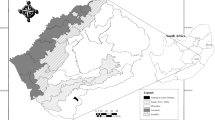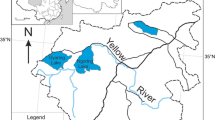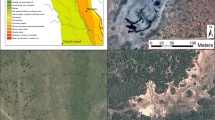Abstract
The wetlands of Elk Island National Park, located in central Alberta, are characterized by their vegetation and relationships between vegetation, surface water chemistry, and hydrotopographic parameters. Thirteen marsh, swamp, fen, and bog communities are described on the basis of TWINSPAN and the Canadian Wetland Classification System. Species distribution in Elk Island is related to surface water cation gradients of corrected conductivity, pH, calcium, magnesium, and sodium. Hydrotopographic features such as water level, hummock height, elevation of the site, and the number of inlet and outlet streams are of secondary importance. Nutrient levels (nitrogen and phosphorus) in surface waters are less significant. Significant correlations were not obtained between vegetation and surface water nitrate levels or peat depth. Marshes, swamps, and moderate-rich fens at Elk Island are circumneutral in pH and rich in calcium, magnesium, and sodium. Poor fens and bogs are acidic, with lower amounts of mineral cations. The ionic gradient at Elk Island is related to fluctuating water tables and water source (ombrogenous vs. minerogenous). Hydrotopography influences the water chemistry. At Elk Island, marshes and swamps are low elevational wetlands and have the highest number of inlet and outlet streams; fens are found at intermediate elevations with fewer inlet and outlet streams; and bogs are found at the highest elevations with the fewest number of inlet and outlet streams.
Similar content being viewed by others
Literature Cited
Adams, G. D. 1988. Wetlands of the prairies of Canada. Chapter 5. p. 156–198.In C. D. A. Rubec (coordinator) Wetlands of Canada. Ecological Land Classification Series No. 24. Sustainable Development Branch, Environment Canada, Ottawa, Ontario, and Polyscience Publications Inc., Montreal, Quebec, Canada.
Canada Soil Survey Committee, Subcommittee on Soil Classification. 1978. The Canadian system of soil classification. Canadian Department of Agriculture Publication 1646. Supply and Services Canada, Ottawa, Ontario, Canada.
Cowardin, L. M., V. Carter, F. C. Golet, and E. T. LaRoe. 1979. Classification of wetlands and deepwater habitats of the United States. U.S. Department of the Interior, Office of Biological Services, Fish and Wildlife Service. Washington, DC, USA. FWS/OBS-79/31.
Crown, P. 1977. Soil Survey of Elk Island National Park. Agriculture Canada. Research Branch, Soil Research Institute, Soil Survey, Edmonton, Alberta, Canada. Alberta Institute of Pedology S-77-38.
Damman, A. W. H. 1988. Regulation of nitrogen removal and retention inSphagnum bogs and other peatlands. Oikos 51:291–305.
Damman, A. W. H. and J. J. Dowhan. 1981. Vegetation and habitat conditions in Western Head Bog, a southern Nova Scotian plateau bog. Canadian Journal of Botany 59:1343–1359.
D’Elia, C. F., P. A. Steudler, and N. Corwin. 1976. Determination of total nitrogen in aqueous samples using persulfate digestion. Limnology and Oceanography 22:760–764.
Emerson, D. 1977. The surficial geology of the cooking lake moraine, east-central Alberta, Canada. M.Sc. thesis, University of Alberta, Edmonton, Alberta, Canada.
Environment Canada. 1982a. Canadian Climate Normals. Vol. 4. Degree Days. 1951–1980. Publication of the Canadian Climate Program, Atmospheric Environment Service, Downsview, Ontario, Canada.
Environment Canada. 1982b. Canadian Climate Normals. Vol. 6. Frost. 1951–1980. Publication of the Canadian Climate Program, Atmospheric Environment Service, Downsview, Ontario, Canada.
Gauthier, R. 1988. Main peatland vegetation units in the Laurentides park. Proceedings of the 8th International Peat Congress, Leningrad, USSR 1:108–116.
Glaser, P. H., G. A. Wheeler, E. Gorham, and H. E. Wright, Jr. 1981. The patterned mires of Red Lake peatland, northern Minnesota: vegetation, water chemistry, and landforms. Journal of Ecology 69:575–599.
Glaser, P. H., J. A. Janssens, and D. I. Siegel. 1990. The response of vegetation to chemical and hydrological gradients in the Lost River peatland, northern Minnesota. Journal of Ecology 78: 1021–1048.
Gorham, E., S. J. Eisenreich, J. Ford, and M. V. Santelmann. 1984. The chemistry of bog waters. Chapter 15. p. 339–363.In W. Strumm (ed.) Chemical Processes in Lakes, Wiley, New York, NY, USA.
Greening, H. S. and J. Gerritsen. 1987. Changes in macrophyte community structure following drought in the Okefenokee Swamp, Georgia, USA. Aquatic Botany 28: 113–128.
Hale, M. E. 1979. How to Know the Lichens. Second edition. Wm. C. Brown Company Publishers, Dubuque, IA, USA.
Hemond, H. F. 1983. The nitrogen budget of Thoreau’s Bog. Ecology 64:99–109.
Hill, M. O. 1979. TWINSPAN—a fortran program for arranging multivariate data in an ordered two-way table by classification of the individuals and attributes. Ecology and Systematics, Cornell University, Ithaca, NY, USA.
Ireland, R. R. 1982. Moss Flora of the Maritime Provinces. National Museums of Canada, Ottawa. Publications in Botany No. 13.
Janssens, J. A. 1983. Past and extant distribution ofDrepanocladus in North America, with notes on the differentiation of fossil fragments. Journal of the Hattori Botanical Laboratory 54:251–298.
Jeglum, J. K. 1971. Plant indicators of pH and water level in peatlands at Candle Lake, Saskatchewan. Canadian Journal of Botany 49:1661–1676.
Jeglum, J. K. 1972. Boreal forest wetlands near Candle Lake, Central Saskatchewan. The Musk-Ox 11:41–58.
Keddy, P. A. and A. A. Reznicek. 1986. Great lakes vegetation dynamics: The role of fluctuating water levels and buried seeds. Journal of Great Lakes Research 12:25–36.
Lang, A. H. 1974. Guide to the Geology of Elk Island National Park, The Origin of its Hills and other Scenery. The Geological Survey of Canada, Dept. of Energy, Mines and Resources, Ottawa, Ontario, Canada. Miscellaneous Report 22.
Lewis, F. J., E. S. Dowding, and E. H. Moss. 1928. The vegetation of Alberta. II. The swamp, moor, and bog forest vegetation of central Alberta. Journal of Ecology 16:19–70.
Mallik, A. U. and R. W. Wein. 1986. Response of aTypha marsh community to draining, flooding, and seasonal burning. Canadian Journal of Botany 64:2136–2143.
Millar, J. B. 1976. Wetland classification in western Canada. A guide to marshes and shallow open water wetlands in the grasslands and the parklands of the prairle provinces. Canadian Wildlife Service, Environment Canada. Ottawa, Ontario, Canada. Report Series Number 37.
Mitsch, W. J. and J. G. Gosselink. 1986. Wetlands. Van Nostrand Reinhold, New York, NY, USA.
Mitsch, W. J. and J. G. Gosselink. 1993. Wetlands, Second edition. Van Nostrand Reinhold, New York, NY, USA.
Moss, E. H. 1953. Marsh and bog vegetation in northwestern Alberta. Canadian. Journal of Botany 31:448–470.
Moss, E. H. 1983. Flora of Alberta, A Manual of Flowering Plants, Conifers, Ferns and Fern Allies Found Growing Without Cultivation in the Province of Alberta, Canada. Revised by J. G. Packer. University of Alberta, Canada. University of Toronto Press, Toronto, Ontario, Canada.
National Wetland Working Group. 1988. Wetlands of Canada. Ecological Land Classification Series No. 24. Sustainable Development Branch, Environment Canada, Ottawa, Ontario, Canada, and Polyscience Publications Inc., Montreal, Quebec, Canada.
Nicholson, B. J. 1987. Peatland paleoecology and peat chemistry at Mariana Lakes, Alberta. M.Sc. thesis, University of Alberta, Edmonton, Alberta, Canada.
Ovenden, L. and G. R. Brassard. 1989. Wetland vegetation near Old Crow, northern Yukon. Canadian Journal of Botany 67:954–960.
Parks Canada. 1986. Elk Island National Park: Resource description and analysis. Vol 1. Resource Conservation, Elk Island National Park, Alberta, Canada.
Radforth N. W. 1969a. Classification of muskeg. p. 31–52.In I. C. MacFarlane (ed.) Muskeg Engineering Handbook. University of Toronto Press, Toronto, Ontario, Canada.
Radforth N. W. 1969b. Airphoto interpretation of muskeg. p. 53–77.In I. C. MacFarlane (ed.) Muskeg Engineering Handbook. University of Toronto Press, Toronto, Ontario, Canada.
Richardson, C. J., D. L. Tilton, J. A. Kadlec, J. P. M. Chamie, and W. A. Wentz. 1978. Nutrient dynamics of a northern wetland ecosystem. p. 217–241.In R. E. Good, D. F. Whigham, R. L. Simpson (eds.) Freshwater Wetlands. Academic Press, San Francisco, CA, USA.
Rochefort, L. 1987. Biological effects of wet acid deposition on peatland bryophytes. M.Sc. thesis, University of Alberta, Edmonton, Alberta, Canada.
Scace and Associates Ltd. 1976. Elk Island National Park, A Cultural History. Parks Canada, Department of Indian and Northern Affairs, Calgary, Alberta, Canada.
Schuster, R. M. 1953. Boreal Hepaticae. A manual of the liverworts of Minnesota and adjacent regions. American Midland Naturalist 49:257–684.
Schwintzer, C. R. 1981. Vegetation and nutrient status of northern Michigan bogs and conifer swamps with a comparison to fens. Canadian Journal of Botany 59:842–853.
Shay, J. M. and C. T. Shay. 1986. Prairie marshes in western Canada, with specific reference to the ecology of five emergent macrophytes. Canadian Journal of Botany 64:443–454.
Sims, R. A., D. W. Cowell, and G. M. Wickware. 1982. Tassification of fens near southern James Bay, Ontario, using vegetational physiognomy. Canadian Journal of Botany 60:2608–2623.
Sjörs, H. 1950. Regional studies in north Swedish mire vegetation. Botaniska Notiser 2:173–222.
Sjörs, H. 1952. On the relationship between vegetation and electrolytes in North Swedish mire waters. Oikos 2 (1950): 241–258.
Slack, N. G., D. H. Vitt, and D. G. Horton. 1980. Vegetation gradients of minerotrophically rich fens in western Alberta. Canadian Journal of Botany 58:330–350.
Starr, M. R. and J. Laine. 1988. Interactions among peat properties, nutrient contents and water chemistry at Lakkasuo Mire, central Finland. Proceedings of the 8th International Peat Congress, Leningrad, USSR 1:140–147.
Stewart, R. E. and H. A. Kantrud. 1972. Vegetation of prairie potholes, North Dakota, in relation to quality of water and other environmental factors. Hydrology of prairie potholes in North Dakota. U.S. Department of the Interior, Geological Survey Professional Paper 585-D.
Taylor, T. M. C. 1983. The Sedge Family. British Columbia Procincial Museum Handbook #43, Victoria, BC, Canada.
Urban, N. R. and S. E. Bayley. 1988. The relative importance of denitrification and nitrate assimulation in midcontinental bogs. Limnology and Oceanography 33:1611–1617.
Urban, N. R. and S. J. Eisenreich. 1988. Nitrogen cycling in a forested Minnesota bog. Canadian Journal of Botany 66:435–449.
Verhoeven, J. T. A., E. Maltby, and M. B. Schmitz. 1990. Nitrogen and phosphorus mineralization in fens and bogs. Journal of Ecology 78:713–726.
Vitt, D. H. and R. E. Andrus. 1977. The genusSphagnum in Alberta. Canadian Journal of Botany 55:331–357.
Vitt, D. H. and S. E. Bayley. 1984. The vegetation and water chemistry of four basin mires in northwestern Ontario. Canadian Journal of Botany 62:1485–1500.
Vitt, D. H. and W. L. Chee, 1990. Relationships of vegetation to surface water chemistry and peat chemistry in fens of Alberta, Canada. Vegetatio 89:87–106.
Vitt, D. H. and N. G. Slack. 1975. An analysis of vegetation ofSphagnum-dominated kettle-hole bogs in relation to environmental gradients. Canadian Journal of Botany 53:332–359.
Vitt, D. H. and N. G. Slack. 1984. Niche diversification ofSphagnum relative to environmental factors in northern Minnesota peatlands. Canadian Journal of Botany 62:1409–1430.
Vitt, D. H., P. Achuff, and R. E. Andrus. 1975. The vegetation and chemical properties of the patterned fens in the Swan Hills, north-central Alberta. Canadian Journal of Botany 53:2776–2795.
Vitt, D. H., D. G. Horton, N. G. Slack, and N. Malmer. 1990.Sphagnum-dominated peatlands of the hyperoceanic British Columbia coast: Patterns in surface water chemistry and vegetation. Canadian Journal of Forest Research 20:696–711.
Vitt, D. H., S. E. Bayley, and T-L. **. 1995. Seasonal variation in water chemistry over a bog-rich fen gradient in continental western Canada. Canadian Journal of Fisheries and Aquatic Sciences 52: (in press).
Walker, B. H. and R. T. Coupland. 1970. Herbaceous wetland vegetation in the aspen grove and grassland regions of Saskatchewan. Canadian Journal of Botany 48:1861–1878.
Wassen, M. J., A. Barendregt, M. C. Bootsma, and P. P. Schot. 1989. Groundwater chemistry and vegetation gradients from rich fen to poor fen in the Naardermeer (the Netherlands). Vegetatio 79:117–132.
Weider, R. K. 1985. Peat and water chemistry at Big Run Bog, a peatland in the Appalachian mountains of West Virginia, USA. Biogeochemistry 1:277–302.
Welling, C. H., R. L. Pederson, and A. G. van der Valk. 1988a. Temporal patterns in recruitment from the seed bank during draw-downs in a prairie wetland. Journal of Applied Ecology 25:999–1007.
Welling, C. H., R. L. Pederson, and A. G. van der Valk. 1988b. Recruitment from the seed bank and the development of zonation of emergent vegetation during drawdown in a prairie wetland. Journal of Ecology. 76:483–496.
Wetzel, R. G. 1983. Limnology. 2nd Edition. Saunders College Publishing, Toronto, Ontario, Canada.
Wilcox, D. A. and J. E. Meeker. 1991. Disturbance effects on aquatic vegetation in regulated and unregulated lakes in northern Minnesota. Canadian Journal of Botany 69:1542–1551.
Yefimov, V. N. and Z. S. Yefimova. 1973. Chemical composition of bog water in the northwestern part of European USSR. Soviet Soil Science 641–650. Translated from Pochvovedeniye 1973:27–36.
Zoltai, S. C. and J. D. Johnson. 1987. Relationships between nutrients and vegetation in peatlands of the prairie provinces. p. 535–543.In Proceedings of the Symposium’87 Wetlands/Peatlands, Edmonton, Alberta, Canada.
Zoltai, S. C., F. C. Pollet, J. K. Jeglum, and G. O. Adams. 1975. Develo** a wetland classifications for Canada. p. 497–511.In B. Bernier and C. H. Winget (eds.) Proceedings of the fourth North American Forest Soils Conference. Laval University, Ste. Foy, Quebec, Canada.
Zoltai, S. C., S. Taylor, J. K. Jeglum, G. F. Mills, and J. D. Johnson. 1988. Wetlands of Boreal Canada. Chapter 4. p. 97–154.In C. D. A. Rubec (coordinator) Wetlands of Canada. Ecological Land Classification Series No. 24. Sustainable Development Branch, Environment Canada, Ottawa, Ontario, Canada, and Polyscience Publications Inc., Montreal, Quebec, Canada.
Author information
Authors and Affiliations
Rights and permissions
About this article
Cite this article
Nicholson, B.J. The wetlands of Elk Island National Park: Vegetation classification, water chemistry, and hydrotopographic relationships. Wetlands 15, 119–133 (1995). https://doi.org/10.1007/BF03160665
Received:
Revised:
Accepted:
Issue Date:
DOI: https://doi.org/10.1007/BF03160665




